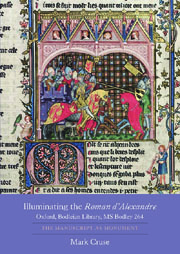 Illuminating the 'Roman d'Alexandre': Oxford, Bodleian Library, MS Bodley 264
Illuminating the 'Roman d'Alexandre': Oxford, Bodleian Library, MS Bodley 264 Book contents
- Frontmatter
- Contents
- List of Illustrations
- Acknowledgements
- Abbreviations
- Introduction
- 1 A Monument to Cortoisie
- 2 Urban Conquest and Spectacle
- 3 “Apraigne d'Alixandre”: Illuminating Exemplarity in Bodley 264
- 4 Alexander, Crusade, and the East in Bodley 264
- 5 The Production, Patronage, and Later Reception of Bodley 264
- Conclusion: Alexander in the Late Middle Ages
- Afterword: Mirror In Pixels
- Bibliography
- Index
- Already Published
Conclusion: Alexander in the Late Middle Ages
Published online by Cambridge University Press: 05 February 2013
- Frontmatter
- Contents
- List of Illustrations
- Acknowledgements
- Abbreviations
- Introduction
- 1 A Monument to Cortoisie
- 2 Urban Conquest and Spectacle
- 3 “Apraigne d'Alixandre”: Illuminating Exemplarity in Bodley 264
- 4 Alexander, Crusade, and the East in Bodley 264
- 5 The Production, Patronage, and Later Reception of Bodley 264
- Conclusion: Alexander in the Late Middle Ages
- Afterword: Mirror In Pixels
- Bibliography
- Index
- Already Published
Summary
The later additions to Bodley 264 in England are important not only for what they tell us about the reception of this particular copy of the interpolated Roman d'Alexandre, but also as evidence for Alexander's status in late medieval Europe more generally. Certainly the times caught up to the manuscript, but this does not mean that generations of readers, even in the fifteenth and sixteenth centuries, did not find the manuscript meaningful. Yet there has long been a view, most stridently articulated by George Cary in his study The Medieval Alexander, that the late medieval Alexander was an empty icon: “The old Alexander, the conqueror, dwindled into the pageant figure of the Nine Worthies”; courtly love “was foisted upon Alexander”; “the various medieval conceptions of Alexander … are mingled in general decay” in the late Middle Ages; “the fourteenth century produced nothing except the addition of the last elaborations to the Roman d'Alexandre in the Vœux du Paon and its sequels.” Cary's assertions echo Huizinga's appraisal of late-medieval secular, and especially courtly, culture as an array of empty forms and ceremonies. Much scholarship over the last thirty years has dispelled this image, of course, but the medieval/Renaissance divide is still very much with us.
- Type
- Chapter
- Information
- Illuminating the 'Roman d'Alexandre': Oxford, Bodleian Library, MS Bodley 264The Manuscript as Monument, pp. 199 - 204Publisher: Boydell & BrewerPrint publication year: 2011


